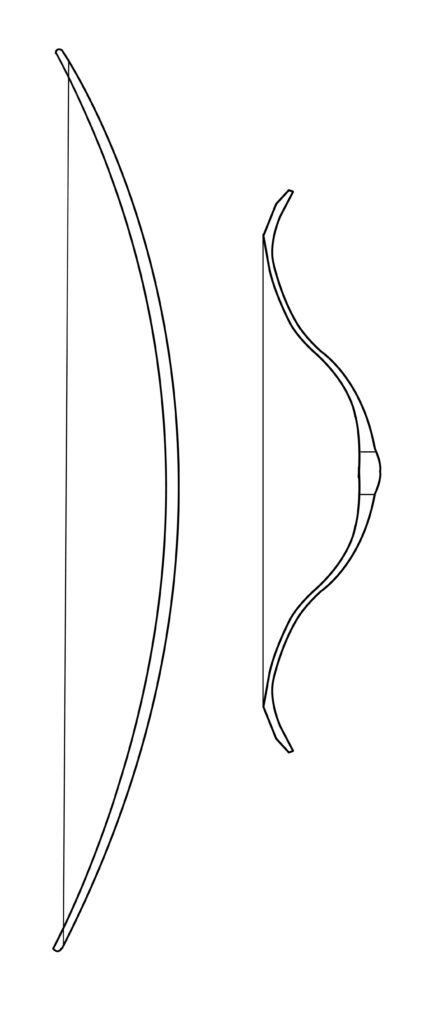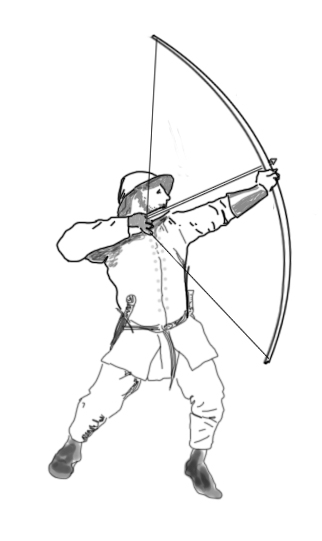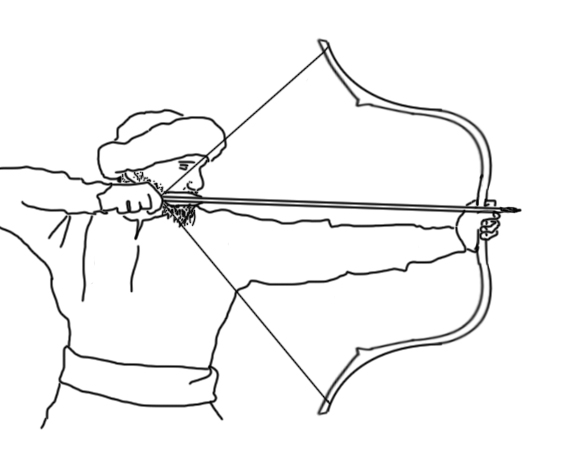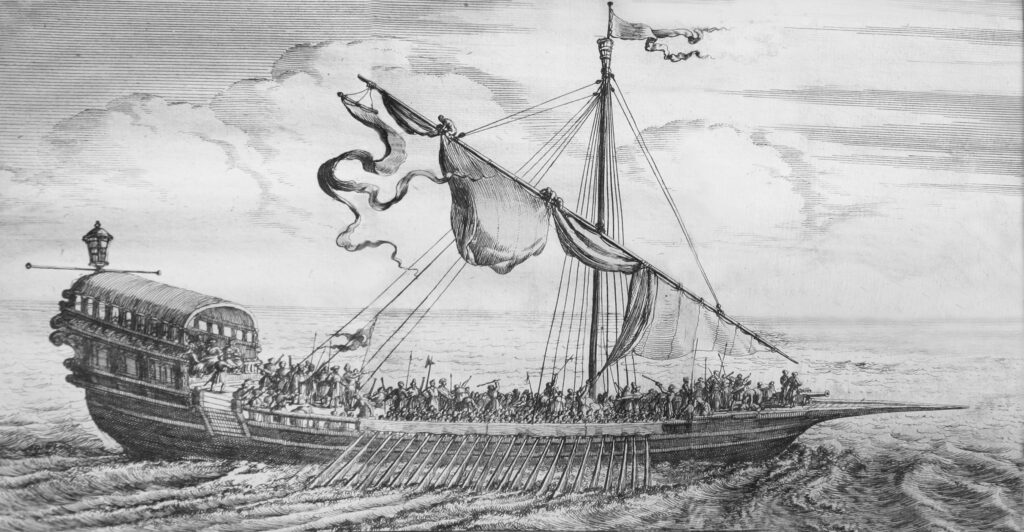The image at the top of this post is a digital reproduction of a seventeenth century painting depicting a sea battle between Barbary corsair galleys and Dutch ships. Though it’s difficult to make out, the corsair galley in the foreground includes something very interesting: among the crowd of men on the galley’s deck there appears to be several archers.
Look at the zoomed-in image below.
In this close-up image, you can make out a man in a white turban shooting a longbow, with what appears to be a second bowman to the left of him (standing in front of the mast).
This seems surprising at first. After all, this was the age of the cannon, of thunderous broadsides and clouds of pungent gun smoke rolling across the water. Did the painter of this scene employ artistic license and just make these bowmen up?
If not, what were archers doing on a corsair galley?
It turns out that the painter didn’t make them up. There really were archers on corsair galleys, though as the decades passed, they became rarer and rarer.
The painter did take a certain artistic license in his depiction of these corsair bowmen, however: he depicted them using longbows. This was a mistake, but a natural one. When Europeans of the time thought of bows, they automatically thought of longbows.
A longbow was essentially a bent stick (they are still sometimes referred to as “stick bows”), an elegant wand carved from a single piece of wood. The best longbows were made from yew wood. They could be anything up to six feet (1.8 meters) long and were powerful weapons. The ‘draw’ on a longbow—that is, the number of pounds of pressure necessary to draw the bow back all the way to shoot the arrow—could be as much as 125 pounds (56 kilograms). They had an effective range of about 200 yards (180 meters), and if the arrows were tipped with what were known as bodkin points, they could pierce armor—as the French knights discovered to their horror at the Battle of Agincourt in 1415, when the English longbow first revealed itself to be a “weapon of mass destruction.”
By the seventeenth century, however, the longbow was no longer used as a weapon of war. Armor was a thing of the past, and the gun had completely replaced the bow.
In the Muslim Mediterranean world, however, the story was a little different.
Firstly, the bow they used was not made from a single piece of wood. Instead it was of a composite construction, with a wooden core and layers of sinew laminated onto the back (the side of the bow facing away from the archer) and animal horn on the belly (the side of the bow facing the archer). Moreover, it was a recurve bow: the tips curved away from the archer. It was also much smaller than the longbow, averaging a little over 40 inches (barely over a meter) when strung. The ‘draw’ weight averaged about 65 pounds (30 kilograms), so it wasn’t as powerful as a longbow, but it had a range of anything up to 450 yards (410 meters). The combination of its composite structure and recurve shape gave the Ottoman bow more ‘spring,’ enabling it to launch an arrow at greater speed and so achieve greater distance.
The illustration below gives you a sense of how the two bows compared with each other.
As you can see, the Ottoman bow is considerably smaller than the longbow.
The two bows were also shot differently.
The longbowman used a finger release, hooking the bowstring in the crook of the first joints of the first three fingers of his hand, (those fingers being protected by a leather tab or glove) and resting the arrow on the outside of his bow hand. You can see this sort of release in the illustration below.
The Ottoman archer used a thumb release, holding the bowstring in the crook of his thumb (his thumb being protected by a ring of horn) and resting the arrow on the thumb of his bow hand. You can see this sort of release in the illustration below.
So why were Barbary corsairs still using bows in the seventeenth century while their European counterparts were not?
The answer lies both with the bows themselves and with the style of shooting.
Longbows were large, cumbersome weapons best used in an open field. In the cramped confines of a seventeenth century ship’s deck, with rigging lines crisscrossing everywhere you looked, they were of limited usefulness.
The small size of the Ottoman bow, on the other hand, made it much easier to use aboard a crowded ship.
Shooting style also played a role.
If you were a right-handed longbowman, you drew the arrow with your right hand from a quiver hung on the right side of your body, but you had to rest the arrow on the outside of your left hand—on the left side of the bow—before you knocked it, drew it back, and fired.
If you were a right-handed Ottoman archer, you drew the arrow with your right hand from a quiver hung on the right side of your body, but you rested the arrow on your thumb—on the right side of the bow. This might seem like a small difference in technique, but it made a large ergonomic difference. Trained Ottoman archers could shoot with amazing speed, knocking arrows, slapping them to the bow against their thumb, drawing the arrow, and firing—all in one smooth, fast motion.
So the combination of their smaller size, fast rate of fire, and long range made Ottoman bows more formidable weapons of war than longbows—especially at sea.
Unlike European ships, corsair galleys didn’t rely on broadsides. Instead, they rammed their prey and boarded them. The deck of the corsair galley in the illustration at the top of this post is so crowded because corsairs needed a large enough number of men to overwhelm they prey when it came time for boarding.
Here’s an image showing just how crowded the deck of a corsair galley could be:
Boarding eventually came down to brutal hand-to-hand combat with pikes, swords, knives, belaying pins—whatever came to hand. In order to get aboard a prey ship, however, corsairs first had to clear the decks. Doing this required the use of small arms like pistols or muskets—and also bows. A few experienced corsair bowmen—backed up by musketeers—could keep up a withering fire, making sure that the men aboard the prey ship kept their heads down, allowing the rest of the corsairs to swarm aboard.
So Ottoman bows were useful weapons long after longbows were.
They didn’t last forever, though. By the end of the seventeenth century, they too seem to have disappeared, replaced, like the long bow, by muskets and pistols—outmoded by the advancing technology of war.

Corsairs and Captives
Narratives from the Age of the Barbary Pirates
View Amazon listing
The Travels of Reverend Ólafur Egilsson
The story of the Barbary corsair raid on Iceland in 1627
View Amazon listing




